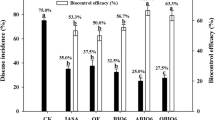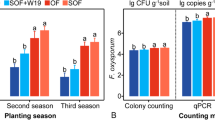Abstract
Fusarium wilt is one of the most serious diseases caused by a soil-borne pathogen affecting banana production. The goal of this study was to evaluate the capability of a novel bio-organic fertilizer (BIO2) that integrated the biocontrol agent Bacillus subtilis N11, and mature composts to control Fusarium wilt of banana in pot experiments. The results showed that the application of the BIO2 significantly decreased the incidence rate of Fusarium wilt compared to the control. To determine the antagonistic mechanism of the strain, we also studied the colonization of the natural biocontrol agent on banana roots using a GFP marker. The studies were performed in a hydroponic culture system, a sand system and a natural soil system. The results indicated that the bacteria colonized predominantly by forming biofilms along the elongation and differentiation zones of the roots. The fact that similar observations were obtained in all three systems suggests that colonization by N11 can be studied in a defined system. The population of B. subtilis N11 in the rhizosphere and on banana roots was also monitored. We speculate that the colonization pattern of B.subtilis N11 can be linked to the mechanism of protection of plants from fungal infection.





Similar content being viewed by others
Abbreviations
- BIO:
-
Bioorganic fertilizer
- CFU:
-
Colony forming unit
- CLSM:
-
Confocal laser scanning microscopy
- FOC:
-
Fusarium oxysporum f. sp. cubense
- GFP:
-
Green fluorescent protein
References
Anith KN, Manomohandas TP (2001) Combined application of Trichoderma harzianum, Alcaligenes sp. strain AMB 8 for controlling nursery rot disease of black pepper. Indian Phytopathol 54:335–339
Assmus B, Hutzler P, Kirchhof G, Amann R, Lawrence JK, Hartmann A (1995) In situ localization of Azospirillum brasilense in the rhizosphere of wheat with fluorescently labeled rRNA-target oligonucleotide probes, scanning confocal laser microscopy. Appl Environ Microbiol 61:1013–1019
Bais HP, Weir TL, Perry LG, Gilroy S, Vivanco JM (2006) The role of root exudates in rhizosphere interactions with plants, other organisms. Annu Rev Plant Biol 57:233–266
Bloemberg GV, Wijifjes AHM, Lamers GEM, Stuurman N, Lugtenberg BJJ (2000) Simultaneous imaging of Pseudomonas fluorescens WCS365 populations expressing three different autofluorescent Proteins in the Rhizosphere, New Perspectives for Studying Microbial Communities. Mol Plant Microb Interact 13:1170–1176
Brigidi P, De Rossi E, Riccard G, Matteuzzi D (1991) A highly efficient electroporation system for transformation of Bacillus licheniforms. Biotechnol Tech 5:5–8
Cavaglieri L, Orlando J, Rodriguez MI (2005) Biocontrol of Bacillus subtilis against Fusarium verticillioides in vitro, at the maize root level. Res Microbiol 156:748–754
Chalfie M, Euskirchen YTG, Ward WW, Prasher DC (1994) Green fluorescent protein as a marker for gene expression. Science 264:802–805
Chelius MK, Triplett EW (2000) Immunolocalization of dinitrogenase reductase produced by Klebsiela pneumoniae in association with Zea mays L. Appl Environ Microbiol 66:783–787
Chen LH, Yang XM, Raza W, Li JH, Zhang FG, Tang Z, Liu YX, Shen QR (2010) Trichoderma harzianum SQR-T037 rapidly degrades allelochemicals in rhizospheres of continuously cropped cucumbers. Appl Microbiol Technol (on line)
Compant S, Duffy B, Nowak J, Clement C, Barka EA (2005) Use of plant growth-promoting bacteria for biocontrol of plant diseases principles, mechanisms of action, future prospects. Appl Environ Microbiol 71:2951–4959
Compant S, Clement C, Sessitsch A (2010) Plant growth-promoting bacteria in the rhizo-, endosphere of plants: their role, colonization, mechanisms involved, prospects for utilization. Soil Biol Biochem 42:669–678
Cotxarrera L, Trillas-Gay MI, Steinberg C, Alabouvette C (2002) Use of sewage sludge compost, Trichoderma asperellum isolates to suppress Fusarium wilt of tomato. Soil Biol Biochem 34:467–476
Dandurand LM, Schotzko DJ, Knudsen GR (1997) Spatial patterns of rhizoplane populations of Pseudomonas fluorescens. Appl Environ Microbiol 63:3211–3217
de Weger LA, Dekkers LC, van der Bij A, Lugtenberg BJJ (1993) Use of phosphate-reporter bacteria to study phosphate limitation in the rhizosphere, in bulk soil. Mol Plant Microb Interact 7:32–38
Duffy BK, Weller DM (1996) Biological control of take-all of wheat in the Pacific North-west of the USA using hypovirulent Gaeumannomyces graminis var. tritici, fluorescent Pseudomonads. J Phytopathol 144:11–12
Dunne C, Delany I, Fenton A, O’Gara F (1996) Mechanisms involved in biocontrol by microbial inoculants. Agronomie 16:721–729
Getha K, Vikineswary S (2002) Antagonistic effects of Streptomyces violaceusniger strain G10 on Fusarium oxysporum f. sp. cubense race 4: indirect evidence for the role of antibiosis in the antagonistic process. J Ind Microbiol Biotechnol 28:303–310
Getha K, Vikineswary S, Wong WH, Seki T, Ward A, Goodfellow M (2005) Evaluation of Streptomyces sp. strain g10 for suppression of Fusarium wilt, rhizosphere colonization in pot-grown banana plantlet. J Ind Microbiol Biotechnol 32:24–32
Gilroy S, Jones DL (2000) Through form to function, root hair development, nutrient uptake. Trends Plant Sci 5:56–60
Hiddink GA, van Bruggen AHC, Raaijmakers JM, Semrnoy AV (2005) Effect of organic management of soils on suppressiveness to Gaeumannomyces graminis var. tritici, its antagonist, Pseudomonas fluorescens. Eur J Plant Pathol 113:417–435
Jaeger CH, Lindow SE, Miller W, Clark E, Firestone MK (1999) Mapping of sugar, amino acid availability in soil around roots with bacterial sensors of sucrose, tryptophan. Appl Environ Microbiol 65:2685–2690
Lin YH, Chang JY, Liu ET, Chao CP, Huang JW, Fang P, Chang LD (2009) Development of a molecular marker for specific detection of Fusarium oxysporum f. sp. cubense race 4. Eur J Plant Pathol 123:353–365
Ling N, Xue C, Huang QW, Yang XM, Xu YC, Shen QR (2010) Development of a mode of application of bio-organic fertilizer for improving the biocontrol efficacy to Fusarium wilt. Biocontrol 55:673–683
Liu XM, Zhou HX, Chen SF (2006) Colonization of Maize, Rice plants by strain Bacillus megaterium C4. Curr Microbiol 52:186–190
Luo J, Ran W, Hu J, Yang XM, Xu YC, Shen QR (2010) Application of bioorganic fertilizer significantly affected fungal diversity of soils. Soil Sci Soc Amer J 74:2039–2048
Marschner P, Rengel Z (2007) Contributions of rhizosphere interactions to soil biological fertility. Soil Biological Fertility 81–98
Mcinroy JA, Kloepper JW (1994) Studies on the indigenous endophytic bacteria of sweet corn, cotton. In: O’Gara F, Dowling DN, Boesten B (eds) Molecular ecology of rhizosphere micro-organisms. VCH Press, pp 19–28
Njoloma J, Tanaka K, Shimizu T, Nishiguchi T, Zakria M, Akashi R, Oota M, Akao S (2006) Infection, colonization of aseptically micropropagated sugarcane seedlings by nitrogen-fixing endophytic bacterium, Herbaspirillum sp. B501gfp1. Biol Fertil Soils 43:137–143
O’Donnell K, Kistler HC, Cigelnik E, Ploetz RC (1998) Multiple evolutionary origins of the fungus causing Panama disease of banana: Concordant evidence from nuclear, mitochondrial gene genealogies. PNAS 95:2044–2049
Ploetz RC (1990) Population biology of Fusarium oxysporum f.sp.cubense. In: Ploetz RC (ed) Fusarium wilt of banana. APS, St. Paul
Prosser JI (1994) Molecular marker systems for detection of genetically engineered micro-organisms in the environment. Microbiol 140:5–17
Raguchander T, Jayashree K, Samiyappan R (1997) Management of Fusarium wilt of banana using antagonistic microorganisms. J Biol Control 11:101–105
Ramey BE, Koutsoudis M, von Bodman SB, Fuqua C (2004) Biofilm formation in plant-microbe associations. Curr Opin Microbiol 7:602–609
Ramos C, Molbak L, Molin S (2000) Bacterial activity in the rhizosphere analyzed at the single-cell level by monitoring ribosome contents, synthesis rates. Appl Environ Microbiol 66:801–809
Saravanan T, Muthusamy M, Marimuthu T (2003) Development of integrated approach to manage the fusarial wilt of banana. Crop Prot 22:1117–1123
Schonwitz R, Ziegler H (1989) Interaction of maize roots, rhizosphere microorganisms. J Plant Nutr Soil Sci 152:217–222
Sivamani E, Gnanamanickam SS (1988) Biological control of Fusarium oxysporum f.sp. cubense in banana by inoculation with Pseudomonas fluorescens. Plant Soil 107:3–9
Snyder W, Hanson H (1940) The species concept in Fusarium. Am J Bot 27:64–67
Timmusk S, Grantcharova N, Wagner EGH (2005) Paenibacillus polymyxa invades plant roots and forms biofilm. Appl Environ Microbiol 71:7292–7300
Tombolini R, van der Gaag DJ, Gerhardson B, Jansson JK (1999) Colonization pattern of the biocontrol strain Pseudomonas chlororaphis MA342 on barley seeds visualized by using green fluorescent protein. Appl Environ Microbiol 65:3674–3680
Trevors JT, Chassy BM, Dower WJ, Blaschek HP (1992) Electrotransformation of bacteria by plasmid DNA. In: Chang DC, Chassy BM, Saunders JA, Sowers AE (eds) Guide to electroporation, electrofusion. Academic, San Diego, pp 265–290
Trillas MI, Casanova E, Corxarrera L, Ordovas J, Borrero C, Aviles M (2006) Composts from agricultural waste, the Trichoderma asperellum strain T-34 suppress Rhizoctonia solani in cucumber seedlings. Biol Control 39:32–38
Unge A, Jansson JK (2001) Monitoring population size, activity, distribution of gfp-luxAB -tagged Pseudomonas fluorescens SBW25 during colonization of wheat. Microb Ecol 41:290–300
von der Weid I, Artursson V, Seldin L, Jansson JK (2005) Antifungal, Root Surface Colonization Properties of GFP-Tagged Paenibacillus brasilensis PB177. World J Microbiol Biotechnol 12:1591–1597
Walker R, Rossall S, Ashe MJC (2002) Colonization of the developing rhizosphere of sugar beet seedlings by potential biocontrol agents applied as seed treatments. J Appl Microbiol 92:228–237
Walker TS, Bais HP, Grotewold E, Vivanco JM (2003) Root exudation, rhizosphere biology. Plant Physiol 132:44–51
Xue GP, Johnson JS, Dalrympl BP (1999) High osmolarity improves the electro-transformation efficiency of the gram-positive bacteria Bacillus subtilis, Bacillus licheniforms. J Microbiol Meth 34:183–191
Zhang SS, Raza W, Yang XM, Hu J, Huang QW, Xu YC, Liu XH, Ran W, Shen QR (2008) Control of Fusarium wilt disease of cucumber plants with the application of a bioorganic fertilizer. Biol Fertil Soils 44:1073–1080
Zhao QY, Dong CX, Yang XM, Mei XL, Ran W, Shen QR (2010) Biocontrol of Fusarium wilt disease for Cucumis melo melon using bio-organic fertilizer. Appl Soil Ecol 47:67–75
Acknowledgement
We gratefully acknowledge Agricultural Ministry of China (201103004), Nature Science Foundation of China (31070462) and Ministry of Science and Technology of China (2010AA10Z401).
Author information
Authors and Affiliations
Corresponding authors
Additional information
Responsible Editor: Harsh P. Bais.
Rights and permissions
About this article
Cite this article
Zhang, N., Wu, K., He, X. et al. A new bioorganic fertilizer can effectively control banana wilt by strong colonization with Bacillus subtilis N11. Plant Soil 344, 87–97 (2011). https://doi.org/10.1007/s11104-011-0729-7
Received:
Accepted:
Published:
Issue Date:
DOI: https://doi.org/10.1007/s11104-011-0729-7




